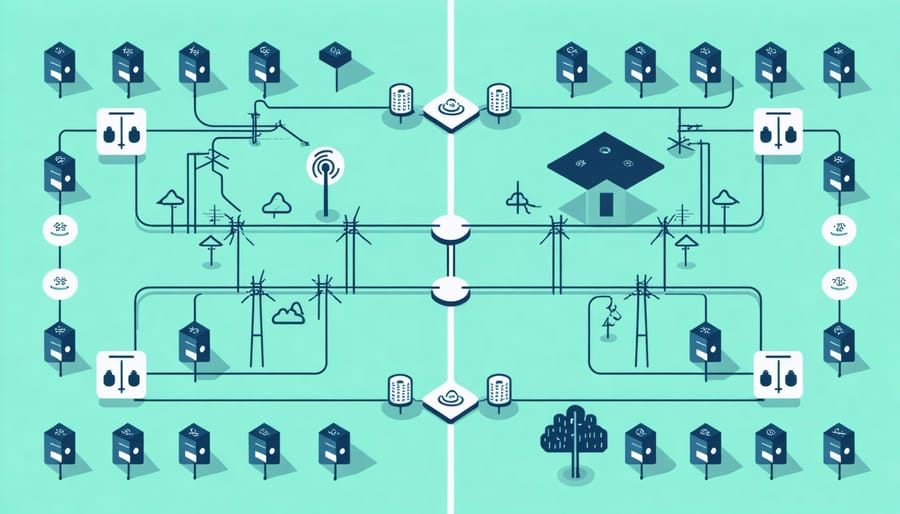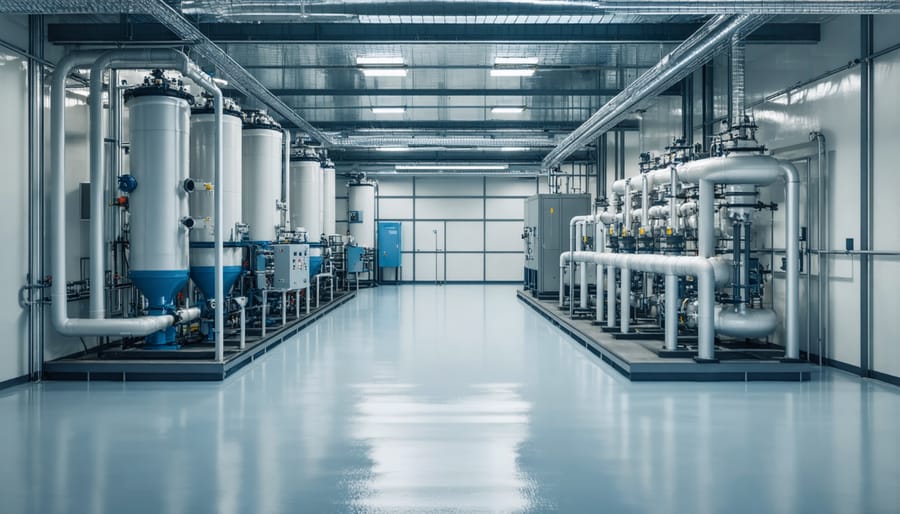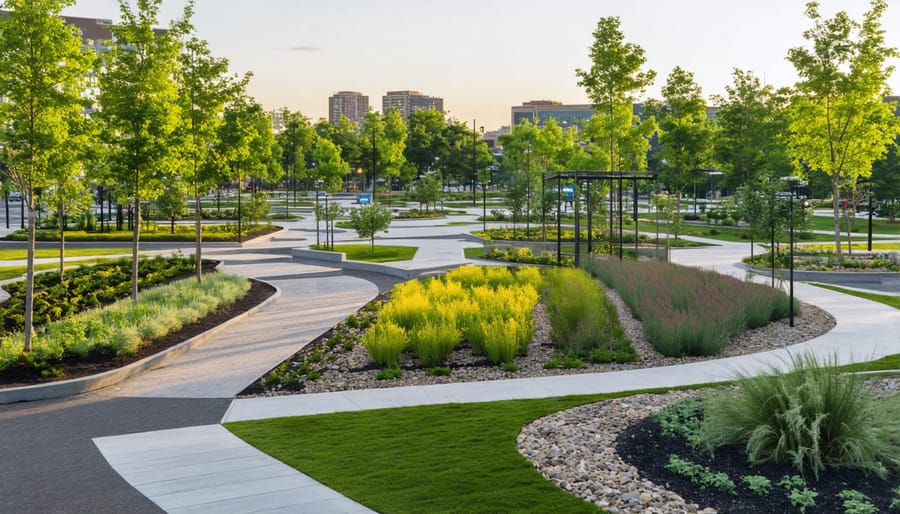Water infrastructure stands as the cornerstone of modern civilization, fundamentally revolutionizing urban living through innovative engineering solutions. From massive hydroelectric dams to sophisticated urban water treatment facilities, these critical systems form the backbone of sustainable development and public health. Recent technological advancements have transformed traditional water management approaches, introducing smart sensors, automated control systems, and integrated digital networks that optimize resource distribution and maintenance protocols. As cities worldwide face mounting pressures from climate change and population growth, understanding the diverse range of water infrastructure examples becomes crucial for industry professionals tasked with designing resilient water systems. This comprehensive exploration examines cutting-edge water infrastructure projects, analyzing their implementation strategies, technical specifications, and long-term impact on urban development.

Smart Water Distribution Networks
Real-time Leak Detection Systems
Modern water infrastructure increasingly relies on sophisticated leak detection systems as a cornerstone of critical infrastructure security. These systems employ a combination of acoustic sensors, pressure monitoring devices, and AI-powered analytics to identify and locate leaks with unprecedented precision.
Advanced acoustic monitoring systems utilize sensitive hydrophones placed strategically throughout the network to detect the distinct sound signatures of water leaks. These sensors can pinpoint leaks within a few meters, dramatically reducing response time and repair costs. Pressure monitoring systems complement acoustic detection by tracking sudden pressure changes that indicate potential breaches in the system.
Recent implementations in major metropolitan areas have demonstrated significant improvements in leak detection efficiency. For example, the Singapore PUB’s Smart Water Grid system reduced water losses by 5% within its first year of operation by integrating real-time monitoring with predictive analytics.
Smart sensors now incorporate machine learning algorithms that can differentiate between normal flow variations and actual leaks, minimizing false alarms. These systems transmit data to central monitoring stations where operators can immediately assess the severity of detected leaks and prioritize maintenance responses.
The return on investment for these systems is compelling, with most utilities reporting detection of leaks up to 18 months earlier than traditional methods, resulting in substantial water conservation and cost savings.
Pressure Management Solutions
Automated pressure regulation systems represent a critical component in modern water infrastructure, offering precise control over water distribution networks while minimizing waste and reducing system stress. These sophisticated systems utilize real-time monitoring and advanced algorithms to maintain optimal pressure levels throughout the network, regardless of demand fluctuations or time of day.
Key benefits include significant reduction in water losses through leakage, with many municipalities reporting savings of 25-30% after implementation. The systems automatically adjust pressure based on consumption patterns, reducing unnecessary strain on pipes during low-demand periods, typically during nighttime hours.
Case studies from major urban centers demonstrate the effectiveness of these solutions. For instance, the City of Toronto’s pressure management program achieved a 30% reduction in pipe breaks and a 15% decrease in overall water loss within the first year of implementation. The system pays particular attention to critical pressure points, using strategically placed sensors and control valves to maintain optimal service levels.
Modern pressure management solutions also incorporate predictive maintenance capabilities, analyzing data patterns to identify potential issues before they become critical. This proactive approach has proven especially valuable in aging infrastructure systems, where preventive measures can significantly extend asset lifespans and reduce emergency repair costs.
These systems typically include:
– Remote monitoring capabilities
– Automated control valves
– Real-time data analytics
– Integration with SCADA systems
– Smart pressure optimization algorithms
Advanced Treatment Facilities
Membrane Filtration Plants
Membrane filtration plants represent a cutting-edge approach to water treatment, utilizing advanced separation technologies to produce high-quality water for municipal and industrial applications. These facilities employ various membrane types, including microfiltration (MF), ultrafiltration (UF), nanofiltration (NF), and reverse osmosis (RO), each serving specific purification needs.
Modern membrane plants typically feature modular designs that allow for scalability and operational flexibility. The core system consists of membrane modules housed in pressure vessels, supported by pre-treatment facilities, cleaning systems, and automated control mechanisms. This configuration enables treatment capacities ranging from small community systems processing 1 MGD to large-scale facilities handling over 100 MGD.
Recent technological advances have significantly improved membrane performance and efficiency. The introduction of low-pressure membranes has reduced energy consumption by up to 30% compared to traditional systems. Additionally, smart monitoring systems utilizing real-time data analytics help optimize operation parameters and predict maintenance needs.
Notable examples include Singapore’s Changi NEWater plant, which employs multiple membrane stages to transform wastewater into ultra-pure water for industrial use. In California, the Orange County Groundwater Replenishment System showcases how membrane filtration can support sustainable water reuse initiatives, producing 100 MGD of high-quality water for aquifer recharge.
The implementation cost typically ranges from $2-5 million per MGD capacity, depending on raw water quality and treatment objectives. However, the long-term benefits of reduced chemical usage, improved water quality, and smaller facility footprint often justify the investment.

Resource Recovery Centers
Resource recovery centers represent a paradigm shift in wastewater treatment, transforming traditional treatment plants into facilities that extract valuable resources from waste streams. These advanced facilities recover nutrients like phosphorus and nitrogen, which can be processed into agricultural fertilizers, while also capturing biogas for energy generation.
Modern recovery centers employ sophisticated technologies such as anaerobic digestion systems to break down organic matter, producing methane that powers facility operations or feeds into local energy grids. The Struvite crystallization process, implemented in facilities like Portland’s Columbia Boulevard Wastewater Treatment Plant, recovers phosphorus in the form of struvite crystals, creating a slow-release fertilizer product.
Some facilities are pushing innovation further by recovering rare earth elements and precious metals from wastewater streams. The East Bay Municipal Utility District in California demonstrates this approach, extracting resources while reducing operational costs through energy-neutral processes.
Heat recovery systems are increasingly common, capturing thermal energy from wastewater for district heating networks or facility climate control. The False Creek Energy Centre in Vancouver exemplifies this approach, providing heating to neighboring developments while reducing carbon emissions.
These facilities typically achieve 60-80% resource recovery rates, significantly reducing waste volume while creating new revenue streams. This evolution in water infrastructure demonstrates how treatment facilities can transition from cost centers to value-generating assets, supporting both environmental sustainability and economic viability.
Sustainable Stormwater Management
Green Infrastructure Integration
Green infrastructure integration represents a sustainable approach to urban water management, combining natural processes with engineered solutions. Cities worldwide are implementing bioswales, rain gardens, and permeable pavements to manage stormwater runoff effectively while enhancing urban aesthetics.
Portland, Oregon’s Green Streets program exemplifies successful implementation, featuring over 2,000 bioswales that process approximately 225 million gallons of stormwater annually. These installations utilize native plants and engineered soils to filter pollutants and reduce the burden on traditional drainage systems.
Singapore’s ABC Waters (Active, Beautiful, Clean Waters) program demonstrates comprehensive green infrastructure integration. The Bishan-Ang Mo Kio Park project transformed a concrete canal into a naturalized river, creating a 3.2-kilometer waterway that manages flood risks while providing recreational space.
Rain gardens in Melbourne, Australia, showcase how small-scale interventions can yield significant impacts. These specially designed gardens capture roof runoff and street-level stormwater, filtering it through layers of vegetation and soil before it enters the groundwater system.
Green roofs represent another vital component, with cities like Chicago leading implementation. The City Hall’s green roof manages up to 75% of a one-inch rainfall event, while reducing urban heat island effects and providing habitat for local wildlife.
These solutions demonstrate how natural systems can effectively complement traditional water infrastructure while delivering multiple environmental and social benefits.

Urban Flood Prevention Systems
Modern urban flood prevention systems represent a critical component of climate resilient infrastructure, incorporating sophisticated engineering solutions to protect cities from severe weather events. These systems typically combine traditional flood control methods with innovative technologies and sustainable design principles.
Key elements include advanced stormwater management networks featuring oversized underground retention tanks, permeable pavements, and bioswales that naturally filter and redirect excess water. Cities like Rotterdam have implemented comprehensive flood defense systems, including automated storm surge barriers and water squares that serve as recreational spaces during dry weather while functioning as temporary water storage during heavy rainfall.
Smart sensors and real-time monitoring systems now enable predictive maintenance and early warning capabilities, allowing municipalities to respond proactively to potential flood threats. These technologies integrate with weather forecasting systems to automatically adjust water flow controls and activate emergency protocols when necessary.
Green infrastructure solutions, such as constructed wetlands and rain gardens, complement traditional gray infrastructure by providing natural flood protection while offering additional environmental benefits. For example, Singapore’s Active, Beautiful, Clean Waters Program demonstrates how integrated urban water management can effectively combine flood protection with public amenities and ecological preservation.
Many modern systems also incorporate adaptive design principles, allowing for future capacity expansion and modification as climate patterns and urban development evolve.
Case Studies in Excellence
Singapore’s Marina Barrage stands as a remarkable example of multifunctional water infrastructure, serving as both a flood control system and freshwater reservoir. Completed in 2008, this project transformed Marina Bay into Singapore’s 15th reservoir, providing 10% of the nation’s water needs while protecting low-lying areas from flooding. The facility’s sophisticated crest gates and pumping systems can discharge up to 280 cubic meters per second during heavy rainfall.
The Thames Water Ring Main in London demonstrates excellence in urban water distribution. This 80km tunnel network, operating entirely by gravity, delivers up to 1,300 million liters of water daily across London. The system’s innovative design reduces pumping costs by 20% compared to traditional infrastructure, setting new standards for energy efficiency in water distribution.
In the Netherlands, the Room for the River project exemplifies innovative flood management. Instead of solely relying on higher dikes, the Dutch government implemented a comprehensive approach that included lowering floodplains, creating water buffers, and relocating dikes inland. The project, completed in 2019, protects over 4 million residents while creating new recreational spaces and wildlife habitats.
Australia’s Goldfields Pipeline serves as a testament to engineering longevity. Constructed in 1903 and still operational today, this 530km pipeline delivers water to Western Australia’s Goldfields region. Recent modernization efforts have incorporated smart monitoring systems and predictive maintenance technologies, extending its service life while improving efficiency.
China’s South-to-North Water Diversion Project represents one of the largest water infrastructure initiatives globally. The central route, spanning 1,432km, transfers 9.5 billion cubic meters of water annually from the Yangtze River to Beijing and other northern cities. The project employs advanced water quality monitoring systems and automated control mechanisms throughout its length.
These case studies demonstrate how successful water infrastructure projects combine innovative engineering solutions with environmental considerations and long-term sustainability. Each example showcases different approaches to water management challenges, from flood control to water supply, while incorporating modern technologies and sustainable practices.
The evolution of water infrastructure continues to shape the future of urban development, with emerging trends pointing toward more sustainable, resilient, and technologically advanced solutions. The integration of smart sensors, AI-driven monitoring systems, and sustainable materials has become increasingly prevalent across global water infrastructure projects. These innovations are transforming traditional water management approaches into more efficient, adaptive systems capable of meeting growing urban demands.
Industry experts project significant investments in water infrastructure modernization over the next decade, with particular emphasis on climate resilience and resource optimization. The adoption of nature-based solutions, such as bioswales and constructed wetlands, alongside conventional engineering approaches, represents a hybrid methodology that’s gaining traction worldwide.
Key trends indicate a shift toward decentralized systems, water reuse technologies, and integrated watershed management approaches. These developments are complemented by advances in materials science, offering more durable and sustainable construction options for water infrastructure projects.
Looking ahead, the water infrastructure sector will likely continue to embrace digital transformation, with increased focus on cybersecurity, remote monitoring capabilities, and predictive maintenance systems. Success in future projects will depend on balancing technological innovation with environmental sustainability, while ensuring infrastructure reliability and accessibility for growing urban populations.

